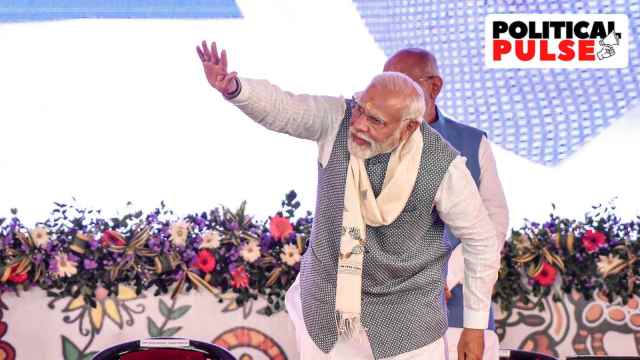Why Opposition is objecting to release of PM-KISAN funds amidst polls
Farmers and beneficiaries of the scheme form big proportion of states going to polls in this round, Cong asks why August-Nov instalment was "delayed" till PM released it Wednesday
 Prime Minister Narendra Modi waves during Jan Jatiya Guarv Diwas and Jharkhand Foundation Day celebrations in Khunti, Jharkhand, Wednesday, Nov. 15, 2023. (PTI Photo)
Prime Minister Narendra Modi waves during Jan Jatiya Guarv Diwas and Jharkhand Foundation Day celebrations in Khunti, Jharkhand, Wednesday, Nov. 15, 2023. (PTI Photo) On Wednesday, Prime Minister Narendra Modi released the 15th instalment of the PM Kisan Samman Nidhi (PM-KISAN) scheme, amounting to Rs 18,000 crore, for more than eight crore farmers across the country.
The announcement came during events for the ‘Janjatiya Gaurav Diwas (tribal pride day)’ in Jharkhand’s Khunti district, where the PM announced other programmes, including the Rs 24,000-crore development mission for Particularly Vulnerable Tribal Groups (PVTGs).
But this disbursement for the PM-KISAN scheme, under which eligible small and marginal farmers receive a minimum income support of Rs 6,000 a year in three instalments, has drawn criticism from the Opposition for its timing during the Assembly elections in five states and two days before voting in Madhya Pradesh and Chhattisgarh on November 17.
On Wednesday, in a post on X, formerly Twitter, Congress MP Jairam Ramesh asked why the 15th instalment was “delayed”. Ramesh cited several past instalments, including the sixth, ninth and twelfth, for the August-November period that were released in August and October. “The 15th instalment under PM-KISAN is coming on November 15, 2023. Now when elections are to be held in Chhattisgarh and Madhya Pradesh in two days, in Rajasthan in 10 days and in Telangana in 15 days, the 15th instalment is being released today. Is this delay not intentional?” Ramesh said.
Congress spokesperson Shama Mohamed, in a post on X on Wednesday, accused Modi of violating the Model Code of Conduct. “If the EC had any teeth, it would pull up the BJP government, but it seems the EC is long dead,” she said.
The Trinamool Congress also used the announcement to attack the BJP Central government’s record on agriculture. “PM Narendra Modi’s so-called concern for farmers: have not doubled farmers’ income as promised; introduced controversial farm Bills and killed 702 farmers; increased cost of seeds, fertiliser and fuel without boosting MSP. Now, he conveniently decides to splash PM-KISAN funds right before five state elections, blatantly violating the Model Code of Conduct. If this isn’t shameless opportunism, what is?” the party said in a post on X on Wednesday.
Scale of PM-KISAN
Launched in 2018, the PM-KISAN scheme grants Rs 6,000 a year in three instalments of Rs 2,000 to eligible farmers.
In its first disbursement, 3.16 crore farmers received a total of Rs 6,323 crore in funding. In 2021-22, more than 10 crore farmers got Rs 67,032 crore for the year.

Among the states going to polls this month, Madhya Pradesh has had the highest average number of beneficiaries across the first 14 instalments for which data is available, followed by Rajasthan and Telangana. At its peak, more than 84 lakh farmers in MP benefited from the scheme.
In the 14th instalment released for the April-July period of 2023-24, MP’s beneficiaries accounted for 8.96% of the total beneficiaries, followed by Rajasthan at 6.67%, Telangana at 3.46%, and Chhattisgarh at 2.37%.

Overall though, UP had the most beneficiaries, with 1.85 crore farmers in the April-July 2023 period, followed by Maharashtra at 85.6 lakh.
Agriculture in poll state economies
The agriculture sector accounted for 18.42% of India’s GDP and 45.76% of the workforce in 2022-23.
Except in Telangana, agriculture contributed more to the state GDPs of Chhattisgarh, Madhya Pradesh and Rajasthan than the national average. But in all four states, the proportion of the workforce engaged in agriculture is higher than the national average – in Chhattisgarh, Madhya Pradesh and Rajasthan, more than half the workforce is involved in agriculture.

Given the heavy reliance on agriculture in these states, it’s no surprise that the sector is a major target for election campaigning and schemes. Similar to the PM-KISAN is Telangana’s popular Rythu Bandhu scheme, which provides Rs 10,000 per year per acre to farmers in the state. Across the poll-bound states, parties have promised similar income support in an attempt to woo farmers.
In Chhattisgarh, rice is a major crop – though it is the country’s eighth largest producer, it ranks third in government procurement. The state’s farmers receive the highest price for their paddy sold to government agencies. For the 2022-23 crop, they were paid a per-quintal price of Rs 2,640 for common and Rs 2,660 for grade ‘A’ paddy, which included the Centre’s MSP of Rs 2,040-2,060 and the state government’s bonus of Rs 600. In the last marketing year, 10.75 metric tonnes (mt) of paddy was purchased from 23.4 lakh farmers, translating into almost Rs 28,500 crore in payments.
Chhattisgarh’s rice revolution through direct procurement from farmers began under the previous Raman Singh-headed BJP regime, which also paid a bonus of Rs 300/quintal on top of the Centre’s MSP. Bhupesh Baghel’s Congress government has promised to hike the paddy purchase price to Rs 3,600/quintal over the next term, if re-elected to power.
MP has the highest total cropped area among these states at 282.8 lakh hectares with an average field growing 1.8 crops. The higher cropping intensity in the state is linked to access to irrigation. Until 2009-10, government canals in the state barely irrigated 8 lakh hectares during the rabi season. That trebled to 23.9 lakh hectares by 2014-15 and crossed 32.6 lakh hectares in the 2022-23 rabi season.
The expansion was partly due to new investments, and also completion of unfinished last-mile projects and improving utilisation of existing irrigation potential, through timely maintenance and concrete lining of canals. Canals apart, the Shivraj Singh Chouhan-led BJP government increased the outstanding power connections for irrigation pumps from 13.2 lakh to over 32.5 lakh between 2010-11 and 2020-21.
Rajasthan has the highest net sown area or land under cultivation at 180.3 lakh hectares in 2019-20. Its agriculture is also, perhaps, the most diversified for any state. The state is India’s top producer of bajra, mustard, moong, guar and barley, and ranks among the top producers for crops including groundnut, jowar, chana, soybean, wheat, onion and cotton. A potential poll issue could be the severe infestation of pink bollworm, which has taken a toll on the fibre crop, especially in the main northern cotton belt of Sri Ganganagar and Hanumangarh.
The ruling K Chandrashekar Rao-led Bharat Rashtra Samithi government’s trump card has been Rythu Bandhu, launched in May 2018 to provide “investment support” to farmers.
Between 2014-15 and 2022-23, Telangana’s total cropped area has risen from 131 lakh acres to 238 lakh acres. The state’s gross irrigated area has more than doubled, from 62.5 lakh to 135 lakh acres, thanks to the Kaleshwaram Lift Irrigation Project and schemes for micro-irrigation and revival of village tanks under Mission Kakatiya.
The BRS government’s schemes have led to a quadrupling of the state’s rice output from 4.4 mt in 2014-15 to 17.5 mt in 2022-23 and a near six-fold jump in paddy procurement (from 2.4 mt to 14 mt) during this period. Telangana is today the second biggest contributor of paddy to the Central pool after Punjab, and is India’s top producer of turmeric, which has become a poll issue with Modi promising to set up a national turmeric board headquartered in the state.


- 01
- 02
- 03
- 04
- 05





























